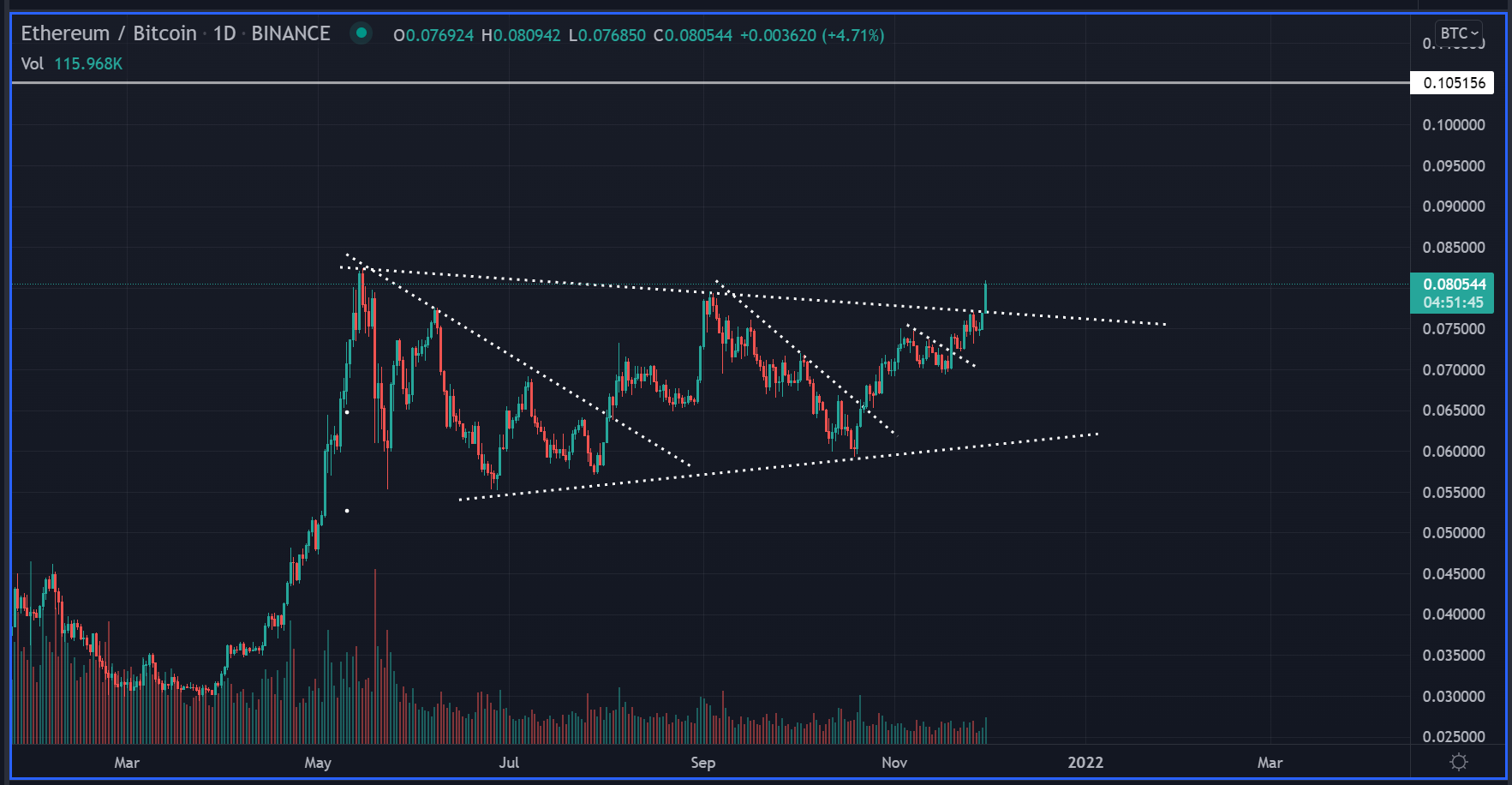Is A Breakout Ahead? Analyzing Ethereum's Price Strength

Table of Contents
Technical Analysis of Ethereum's Chart
Technical analysis provides valuable insights into potential price movements by examining past price data and chart patterns. Analyzing Ethereum's price strength through this lens helps identify potential breakout opportunities.
Identifying Key Support and Resistance Levels
Crucial price levels act as support and resistance zones. For a significant price increase, Ethereum needs to break through these levels. A sustained break above resistance indicates strong bullish momentum, while a fall below support suggests weakening price strength.
- Support Zone: $1,600 - $1,700 (Historically significant support level)
- Resistance Zone: $2,000 - $2,200 (Previous highs act as resistance)
- Breakout Level: A decisive break above $2,200 would signal a strong bullish trend.
Technical indicators such as moving averages (MA), Relative Strength Index (RSI), and Moving Average Convergence Divergence (MACD) provide additional confirmation. A bullish crossover of the 50-day and 200-day MA, coupled with an RSI above 70 and a positive MACD, would strengthen the bullish outlook.
Chart Patterns Suggesting a Potential Breakout
Certain chart patterns can predict future price movements. For example, a symmetrical triangle formation often precedes a significant price break, either upwards or downwards. The direction of the breakout is crucial for determining the strength of the move.
- Symmetrical Triangle: This pattern shows consolidation before a potential breakout, often accompanied by decreasing volume.
- Flag Pattern: A brief period of consolidation within an established trend, usually indicating a continuation of the trend. A breakout above the flag's upper trendline suggests continued upward movement.
Volume confirmation is crucial. A significant price breakout should be accompanied by increased trading volume to validate the move's strength and sustainability.
Analyzing Momentum and Volatility
Bollinger Bands help visualize price volatility and momentum. When the price consistently trades above the upper band, it indicates strong upward momentum and potentially a breakout. Conversely, trading below the lower band shows weakness.
- Bollinger Bands Squeeze: A period of low volatility, where the bands contract, often precedes a period of increased volatility and a potential breakout.
- Volatility Indicators: Analyzing average true range (ATR) can highlight periods of increased volatility that might signal increased price fluctuations.
Fundamental Factors Influencing Ethereum's Price
Ethereum's price strength isn't solely determined by technical factors; fundamental aspects play a significant role.
Ethereum's Network Activity and Transaction Volume
High network activity, reflecting increased usage of the Ethereum blockchain, usually correlates with higher prices. The growth of decentralized finance (DeFi) applications and non-fungible token (NFT) marketplaces significantly impacts Ethereum's transaction volume and consequently, its price.
- Gas Fees: High gas fees can be an indicator of high demand and network congestion, which can be both positive and negative for price.
- DeFi Activity: The total value locked (TVL) in DeFi protocols built on Ethereum directly influences network activity and price.
Upcoming Ethereum 2.0 Developments and Their Impact
The highly anticipated Ethereum 2.0 upgrades, such as sharding and improved scalability, will significantly enhance the network's efficiency and capacity. This positive outlook should have a favorable impact on investor sentiment and, ultimately, the price.
- Staking Rewards: The Ethereum 2.0 staking mechanism offers incentives for locking up ETH, potentially reducing the circulating supply and increasing its value.
- Sharding: Improved scalability through sharding will lower transaction costs and increase throughput, further enhancing the network's appeal.
Regulatory Landscape and its Influence on Ethereum's Price
Government regulations and policies significantly influence the cryptocurrency market. Clearer regulatory frameworks can boost investor confidence and lead to higher prices, while uncertainty can trigger price declines.
- Regulatory Clarity: Positive regulatory developments can lead to increased institutional investment and price appreciation.
- Regulatory Uncertainty: Negative news or unclear regulations can lead to price volatility and potential declines.
Market Sentiment and Investor Behavior
Market sentiment and investor behavior significantly impact Ethereum's price strength.
Analyzing Social Media Sentiment and News Coverage
Social media sentiment and news coverage influence investor perception. Positive news and widespread adoption often result in price increases, while negative news or controversies can lead to price drops.
- Sentiment Analysis Tools: Using tools that analyze social media sentiment helps gauge investor sentiment towards Ethereum.
- News Coverage: Monitoring major news outlets for Ethereum-related news provides insights into potential price drivers.
Investor Confidence and Market Capitalization
Investor confidence is reflected in Ethereum's market capitalization. High market capitalization usually indicates strong investor confidence and potentially sustained price appreciation. Comparing Ethereum's market cap to other cryptocurrencies provides a comparative perspective.
- Market Dominance: Ethereum's market dominance within the cryptocurrency market influences its price strength relative to other assets.
- Fear and Greed Index: Monitoring the crypto fear and greed index helps gauge overall market sentiment which affects ETH's price.
Whale Activity and Institutional Investment
Large investors ("whales") and institutional investment significantly influence Ethereum's price movements. Large transactions can trigger price swings, indicating strong buying or selling pressure.
- On-chain Analysis: Analyzing large ETH transactions on the blockchain reveals potential whale activity and its impact.
- Institutional Adoption: Increased institutional investment signals growing confidence and can contribute to sustained price increases.
Conclusion: Is an Ethereum Breakout Imminent?
Analyzing Ethereum's price strength requires considering technical, fundamental, and sentiment indicators. While technical analysis reveals potential breakout patterns and key support/resistance levels, fundamental factors like Ethereum 2.0 development and network activity contribute to long-term price strength. Positive market sentiment and growing institutional adoption further enhance the possibility of a breakout. However, regulatory uncertainty remains a risk. While this analysis suggests the potential for an Ethereum breakout, remember to conduct thorough due diligence before making any investment decisions. Keep monitoring Ethereum's price strength and stay informed!

Featured Posts
-
 Celtics Vs Nets Jayson Tatums Availability Tonight
May 08, 2025
Celtics Vs Nets Jayson Tatums Availability Tonight
May 08, 2025 -
 Official Statement Marriyum Aurangzeb On Lahore Zoos Increased Ticket Costs
May 08, 2025
Official Statement Marriyum Aurangzeb On Lahore Zoos Increased Ticket Costs
May 08, 2025 -
 Arsenal Ps Zh Barselona Inter Rozklad Ta Prognoz Matchiv 1 2 Finalu Ligi Chempioniv
May 08, 2025
Arsenal Ps Zh Barselona Inter Rozklad Ta Prognoz Matchiv 1 2 Finalu Ligi Chempioniv
May 08, 2025 -
 Conmebol Libertadores Liga De Quito Enfrenta A Flamengo En La Fecha 3 Grupo C
May 08, 2025
Conmebol Libertadores Liga De Quito Enfrenta A Flamengo En La Fecha 3 Grupo C
May 08, 2025 -
 Pik Seged Senzatsionalna Pobeda Nad Pariz Za Plasman U Chetvrtfinale Lige Shampiona
May 08, 2025
Pik Seged Senzatsionalna Pobeda Nad Pariz Za Plasman U Chetvrtfinale Lige Shampiona
May 08, 2025
